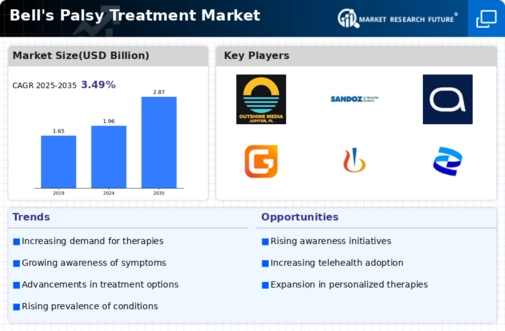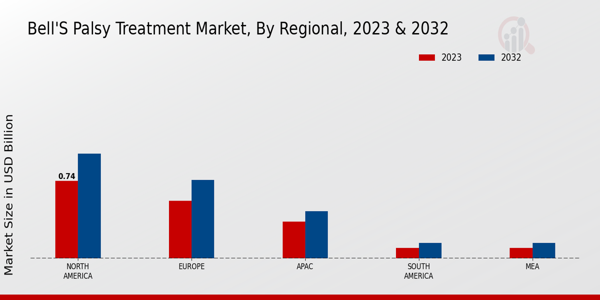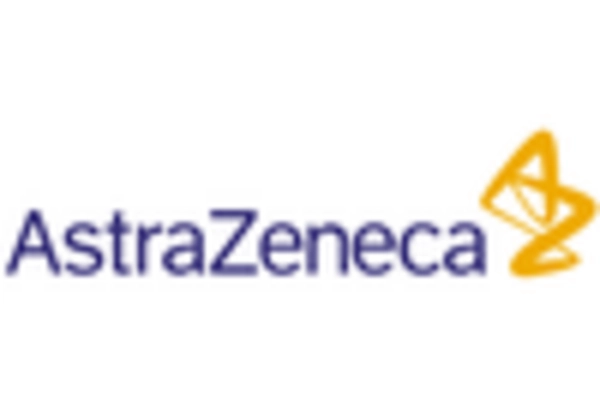Rising Incidence of Bell's Palsy
The Bell's Palsy Treatment Market is experiencing growth due to the rising incidence of Bell's Palsy, which affects approximately 15 to 30 individuals per 100,000 people annually. This increase in cases necessitates effective treatment options, thereby driving demand for therapies and interventions. The condition, characterized by sudden facial paralysis, often leads to significant emotional and psychological distress among patients. As awareness of the condition grows, more individuals seek medical attention, contributing to the expansion of the Bell's Palsy Treatment Market. Furthermore, the increasing prevalence of risk factors such as viral infections and stress may further elevate the incidence rates, prompting healthcare providers to develop and offer more comprehensive treatment solutions.
Advancements in Treatment Modalities
Innovations in treatment modalities are propelling the Bell's Palsy Treatment Market forward. Recent advancements include the development of corticosteroid therapies, antiviral medications, and physical rehabilitation techniques. These innovations aim to enhance recovery rates and minimize long-term complications associated with Bell's Palsy. For instance, corticosteroids have been shown to improve outcomes when administered early in the course of the disease. Additionally, the integration of physical therapy and facial exercises is gaining traction, as they are believed to aid in restoring facial function. The ongoing research into novel therapies, including the potential use of botulinum toxin, suggests a promising future for the Bell's Palsy Treatment Market, as these treatments may offer more effective solutions for patients.
Growing Demand for Telehealth Services
The Bell's Palsy Treatment Market is witnessing a surge in demand for telehealth services, which have become increasingly popular among patients seeking convenient access to healthcare. Telehealth allows individuals to consult with healthcare providers remotely, reducing the barriers associated with traditional in-person visits. This trend is particularly beneficial for patients with Bell's Palsy, who may require ongoing monitoring and support during their recovery. The ability to receive consultations and follow-up care through telehealth platforms can enhance patient engagement and adherence to treatment plans. As telehealth continues to evolve, it is likely to play a crucial role in shaping the Bell's Palsy Treatment Market, offering innovative solutions for patient care.
Rising Awareness and Education Initiatives
The Bell's Palsy Treatment Market is experiencing growth due to rising awareness and education initiatives aimed at both healthcare professionals and the general public. Increased knowledge about Bell's Palsy, its symptoms, and available treatment options is crucial for early diagnosis and intervention. Various organizations and healthcare providers are actively promoting educational campaigns to inform individuals about the condition, which may lead to earlier treatment seeking behavior. This heightened awareness is likely to result in an increase in diagnosed cases, thereby expanding the Bell's Palsy Treatment Market. Furthermore, as more healthcare professionals become educated about the latest treatment protocols, the quality of care provided to patients is expected to improve, further driving market growth.
Increased Investment in Healthcare Infrastructure
The Bell's Palsy Treatment Market is benefiting from increased investment in healthcare infrastructure. Governments and private entities are allocating more resources to enhance healthcare facilities and improve access to treatment for neurological conditions, including Bell's Palsy. This investment is likely to lead to the establishment of specialized clinics and rehabilitation centers, which can provide targeted care for affected individuals. Moreover, the expansion of healthcare infrastructure may facilitate better training for healthcare professionals, ensuring that they are equipped to diagnose and treat Bell's Palsy effectively. As a result, the Bell's Palsy Treatment Market is expected to grow, driven by improved patient access to quality care and treatment options.


















Leave a Comment